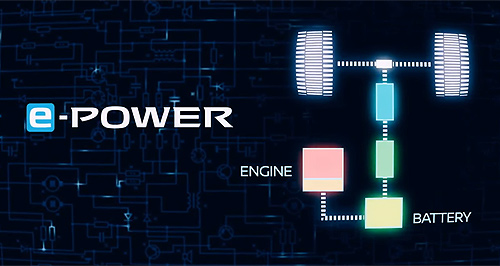Make / Model Search
Future models - Nissan - Note - e-PowerNissan debuts efficient e-Power drivetrainJapan-only Note e-Power first to get Nissan’s new petrol-electric range-extenderGallery Click to see larger images 3 Nov 2016 NISSAN has announced a petrol-electric drivetrain capable of achieving fuel consumption of just 2.7 litres per 100 kilometres in the brand’s Note light car, which is not sold in Australia. The e-Power system is a series hybrid that always uses the electric motor to drive the wheels, in a similar way to the discontinued Holden Volt, except it has no charging socket and relies entirely on a small petrol engine and regenerative braking to keep its battery pack topped up. In addition to improved fuel-efficiency, e-Power is claimed to provide the acceleration response, smoothness and quietness of an electric car without the weight of large battery packs or the inconveniences of finding a charging station and long recharge times. Japan will be the only market to receive the Note e-Power, and sales will be directed at urban areas, but Nissan says the drivetrain is suitable for a broad range of compact cars. As such, the company is expected to roll e-Power out across the smaller end of its line-up, with the all-new Micra that was unveiled at the recent Paris motor show an obvious candidate, as it will replace the Note in Europe once it launches in the first quarter of next year. The Pulsar small car, along with compact crossovers including the Juke and Qashqai could also eventually receive the e-Power treatment. Other vehicles across the Renault-Nissan Alliance could also benefit, as well as future products from Mitsubishi now it has joined the organisation. Nissan Australia general manager of corporate communications Peter Fadeyev told GoAuto it is too early to confirm the e-Power drivetrain for this market, or which models it may feature in. Speaking at the Note e-Power unveiling in Yokohama this week, Nissan senior vice-president Asako Hoshino said the drivetrain was 10 years in the making and brings large-car levels of quietness to the compact segment. She said interior noise levels at 50km/h are equivalent to a D-segment (mid-size car), and similar to those of an E-segment large car at up to 20km/h. According to Ms Hoshino, part of the reason is that the e-Power system requires half the amount of engine running time as a conventional hybrid. By keeping the petrol engine in its efficiency sweet spot of 2000-2500rpm, the Note e-Power could return fuel consumption of between 2.7L/100km and 2.9 l/100km on the Japanese JC08 cycle depending on variant. She added that the powerful regenerative braking system produces strong enough deceleration when lifting off the accelerator that brake pedal use can be reduced by up to 70 per cent in urban driving compared with a purely petrol-powered car. According to a specification sheet on Nissan’s Japanese consumer website, the Note e-Power’s electric motor can produce 80kW of peak power and 254Nm of torque, matching the specifications of the drivetrain fitted to the brand’s rally-inspired Gripz concept revealed at last year’s Frankfurt show. The three-cylinder 1.2-litre petrol generator is derived from the regular Note engine, producing 58kW and 103Nm but uses the Miller combustion cycle favoured by industrial stationary engines and is fed by a 35L tank compared with the 41L tank used in the regular Note, to make space for a rear-mounted 12V ancillary battery. In the Note e-Power, the main high-voltage battery pack is located beneath the front seats, which Nissan claims does not sacrifice interior space. The electric motor, inverter and battery technology are all inherited from Nissan’s pioneering all-electric Leaf hatchback, some components for which are produced in Australia at the Nissan casting plant in Dandenong, Victoria. But the company does not say what size the Note e-Power’s Lithium-ion battery is, other than the fact it is smaller than the Leaf’s 24kWh pack. Nissan describes the e-Power system as providing a gateway to 100 per cent electric cars and furthering the company’s pursuit of 100 per cent emission-free society.  Read more30th of September 2016  Paris show: New Micra has the edgeNissan’s sharp-angled, hi-tech new Micra emerges but local launch not locked in26th of July 2016  Exclusive: Casting remains cash cow for NCAPNissan casting plant sticks with towbar production but casting still core businessAll future modelsMotor industry news |
Click to shareNissan modelsResearch Nissan All future modelsMotor industry news |












 Alfa Romeo
Alfa Romeo Abarth
Abarth Audi
Audi Aston Martin
Aston Martin BMW
BMW Bentley
Bentley Ferrari
Ferrari Chevrolet
Chevrolet Ford
Ford Fiat
Fiat GWM
GWM Foton
Foton Hyundai
Hyundai Honda
Honda Jaguar
Jaguar Isuzu
Isuzu Kia
Kia Jeep
Jeep Land Rover
Land Rover Lamborghini
Lamborghini Maserati
Maserati Lexus
Lexus McLaren
McLaren Mazda
Mazda Mercedes-Benz
Mercedes-Benz Mitsubishi
Mitsubishi Mini
Mini Peugeot
Peugeot Nissan
Nissan Ram
Ram Porsche
Porsche Rolls-Royce
Rolls-Royce Smart
Smart Skoda
Skoda Suzuki
Suzuki Subaru
Subaru Toyota
Toyota Tesla
Tesla Volvo
Volvo Zeekr
Zeekr







Facebook Twitter Instagram